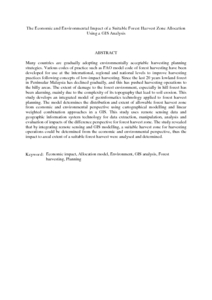Citation
Jusoff, Kamaruzaman and Ismail, Mohd Hasmadi
(2009)
The Economic and Environmental Impact of a Suitable Forest Harvest Zone Allocation Using a GIS Analysis.
International Business Research, 2 (2).
pp. 208-217.
ISSN 1913-9004
Abstract
Many countries are gradually adopting environmentally acceptable harvesting planning strategies. Various codes of
practice such as FAO model code of forest harvesting have been developed for use at the international, regional and
national levels to improve harvesting practices following concepts of low-impact harvesting. Since the last 20 years
lowland forest in Peninsular Malaysia has declined gradually, and this has pushed harvesting operations to the hilly areas. The extent of damage to the forest environment, especially in hill forest has been alarming, mainly due to the complexity of its topography that lead to soil erosion. This study develops an integrated model of geoinformatics technology applied to forest harvest planning. The model determines the distribution and extent of allowable forest harvest zone from economic and environmental perspective using cartographical modelling and linear weighted combination approaches in a GIS. This study uses remote sensing data and geographic information system technology for data extraction, manipulation, analysis and evaluation of impacts of the difference perspective for forest harvest zone. The study revealed that by integrating remote sensing and GIS modelling, a suitable harvest zone for harvesting operations could be determined from the economic and environmental perspective, thus the impact to areal extent of a suitable forest harvest were analysed and determined.
Download File
![[img]](http://psasir.upm.edu.my/6986/1.hassmallThumbnailVersion/The%20Economic%20and%20Environmental%20Impact%20of%20a%20Suitable%20Forest%20Harvest%20Zone%20Allocation%20Using%20a%20GIS%20Analysis.pdf)  Preview |
|
PDF (Abstract)
The Economic and Environmental Impact of a Suitable Forest Harvest Zone Allocation Using a GIS Analysis.pdf
Download (85kB)
| Preview
|
|
Additional Metadata
Actions (login required)
 |
View Item |

